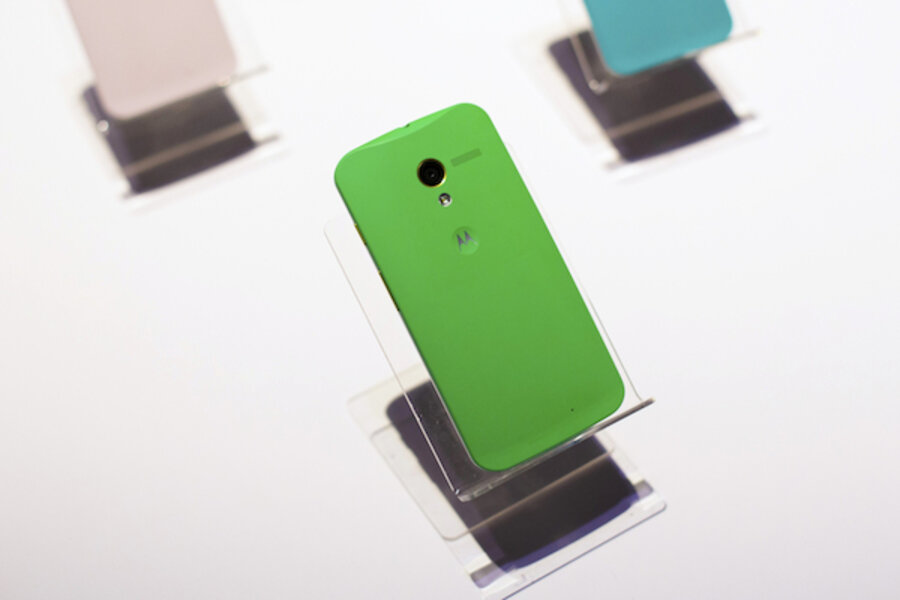Moto X review roundup: Motorola's colorful alternative to the iPhone
Loading...
For the most part, the Moto X, the new phone from Google's Motorola Mobility, is a pretty ordinary smart phone: 4.7-inch display, the Android 4.2.2 Jelly Bean OS, a 10-megapixel camera, and a $199 asking price (plus contract).
What sets it apart from the rest of the pack is a customization scheme called Motomaker, which allows consumers to pick from a massive array of colors, accents, and case options.
The Moto X will debut on all four major carriers on August 23. But is the device actually any good? Well, let's go to the reviews.
The opening shot
"I've been using the Moto X as my sole smartphone since Thursday, putting it through its paces," writes Barbara Krasnoff of Computerworld. "And while the Moto X is not any kind of revolution in mobile technology, neither is it the complete disappointment that some are complaining about. Instead, it is an interesting attempt at a user-friendly and configurable mobile device."
The design
"The width of a phone, more than anything else, defines how comfortable it is to use one-handed," writes Sascha Segan of PC Mag. "The X is 2.57-inches wide, as compared to 2.69-inches for the HTC One and 2.75 inches for the Samsung Galaxy S 4, which makes it noticeably easier to use in one hand. It's also shorter than those two, at 5.09-inches tall, but a little bit thicker, at 0.42-inches thick, and it's between them in weight at 4.6 ounces. Unlike the all-metal HTC One, the Moto X is mostly a plastic phone, but it uses more solid, higher-quality-feeling plastics than the S 4 does, so it weighs a little more."
The display
"It looks good," says Gizmodo's Brent Rose. "Really good, in fact, despite being 720p, not 1080p. It doesn't measure up to the 1080p screens on the HTC One or Galaxy S4, but truth be told, you'd have to be looking very closely to notice any difference (the tiniest bit of pixilation in fine print). At 316 pixel per inch it's only 10 PPI lower than the iPhone 5, and frankly the larger screen is worth the tradeoff."
The performance
"[T]he Moto X does glide along in every action," writes Joseph Volpe of Engadget. "The transitions are smooth and the app launches are seamless; nothing about its performance is herky-jerky. Take my word for it. I'm what you'd consider a heavy user, with tons of tasks living in the background at any given moment, and I've yet to witness the Moto X flinch. It's that good. It also never heats up in hand. Thank you, Motorola."
The unexpected (but pretty cool) features
"Moto X can tell if you're in a moving vehicle and automatically turn on a Driving mode that will read text messages aloud to you, or tell you who's calling – you can automatically respond with a text reply that lets callers know you're behind the wheel," writes Edward C. Baig of USA Today.
The camera
"In low light situations the camera easily competes with the HTC One and Nokia Lumia 928 when it comes to the sensor being able to 'see' in low light," notes Russell Holly of Geek.com. "When capturing images it does a great job demonstrating color accuracy, and the AutoHDR function does an acceptable job balancing the light if there’s ever an issue with the environment you are trying to take a picture in. Unfortunately, in our tests with the camera the truly great shots produced were few and far between. This isn’t because the camera isn’t capable, but because the software often misses the mark in focusing on the correct thing in the photo."
The battery
"Motorola claims the phone can get 24 hours of battery life on a single charge," writes Walter S. Mossberg of the Wall Street Journal. "I didn't perform a formal test, but, in moderate use, making calls, streaming audio and video, doing email, texting and Web surfing, I was able to go well into a second day without charging every night."
The touchless mode
"As with Siri on the iPhone, you can command the phone to dial a number, send a text, open an app, set your alarm, look up a fact on the Web, and so on," writes David Pogue of the New York Times. "But unlike Siri, you don’t hold down a button to speak. The phone is always listening, even when it’s in your car’s cup holder. It works remarkably well, as long as you precede your command with the salutation, 'O.K., Google Now.'"
The parting thoughts
"[T]he phone is nice," writes Joshua Topolsky of The Verge. "I mean, really nice to use. It’s a reminder that the way something is built can be as important as what it’s made of. Combined with the ability to get a truly unique, customized device that’s as compelling as anything I’ve recently tested — one assembled in America – it begins to look like an awfully good option. The Moto X is not a perfect phone, but neither is any other phone on the market right now. What it is, however, is a pretty damn good phone – and one I can recommend."





